Monday Jan 05, 2026
Monday Jan 05, 2026
Thursday, 2 November 2023 00:47 - - {{hitsCtrl.values.hits}}
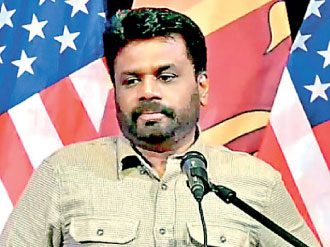
Shift to centre-left
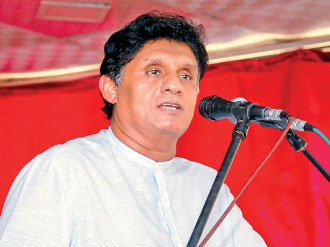
Sajith should tell his story
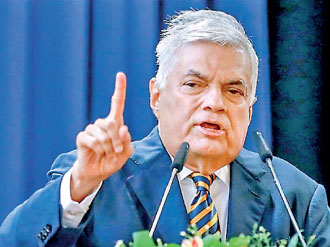
Ranil: Runs a poor third
 Gotabaya’s economics were irrational, Ranil’s politics are no less irrational. His proposals for electoral reform include the idea that legislators can hold office simultaneously at various institutional levels of the democratic system, i.e., a municipal councillor can also sit in Parliament.
Gotabaya’s economics were irrational, Ranil’s politics are no less irrational. His proposals for electoral reform include the idea that legislators can hold office simultaneously at various institutional levels of the democratic system, i.e., a municipal councillor can also sit in Parliament.
Candidates run for a post at a specific level of representation. The voter selects between candidates for that specific job (e.g., Pradeshiya Sabha member, Mayor, Chief Minister, MP, President). That’s why there are different elections to the different levels of the political structure in any country: municipal, regional, national, upper house and lower house, presidential.
The voter doesn’t pick someone for one job, to enable him/her to simultaneously hold an office or offices he/she wasn’t elected to.
Ranil’s suggestion, made publicly by him early in his presidency, upends the basic logic of democracy and will generate a rare combination of immobility and anarchy in the system. It is the political equivalent of Gota’s fertiliser policy.
Political tectonic shifts
The latest figures on Presidential Election (PE) and Parliamentary election voting preferences issued by Dr. Ravindra Ranan-Eliya’s Institute of Health Policy (IHP) SLOTS tracker, come exactly one year from the presidential election.
On the Presidential election, the key takeaways are:
 “IHP’s Sri Lanka Opinion Tracker Survey (SLOTS) MRP estimates of Presidential Election voting intent in September 2023 show NPP/JVP leader A.K. Dissanayake with an increasing lead amongst likely voters at 46%, up seven points in a month.
“IHP’s Sri Lanka Opinion Tracker Survey (SLOTS) MRP estimates of Presidential Election voting intent in September 2023 show NPP/JVP leader A.K. Dissanayake with an increasing lead amongst likely voters at 46%, up seven points in a month.
 SJB leader Sajith Premadasa was second on 29%, and President Ranil Wickremesinghe third on 17%.
SJB leader Sajith Premadasa was second on 29%, and President Ranil Wickremesinghe third on 17%.
 The increase in support for the NPP/JVP leader in the last three months, contrasts with small declines in support for the other major party leaders.” (https://www.ft.lk/front-page/Support-for-AKD-amongst-likely-voters-up-to-46-in-September/44-754464)
The increase in support for the NPP/JVP leader in the last three months, contrasts with small declines in support for the other major party leaders.” (https://www.ft.lk/front-page/Support-for-AKD-amongst-likely-voters-up-to-46-in-September/44-754464)
On the Parliamentary election, here’s the picture:
 “Support for leftist National People’s Power (NPP) among voters has increased by 42 percent, putting them “well ahead” of the main opposition Samagi Jana Balawegaya (SJB), the president’s United National Party (UNP) and the ruling Sri Lanka Podujana Peramuna (SLPP).
“Support for leftist National People’s Power (NPP) among voters has increased by 42 percent, putting them “well ahead” of the main opposition Samagi Jana Balawegaya (SJB), the president’s United National Party (UNP) and the ruling Sri Lanka Podujana Peramuna (SLPP).
 Support amongst likely voters for the NPP/JVP increased to 42 percent (+9). This put them well ahead of the SJB on 22 percent, the UNP on 13 percent, and the SLPP on 8 percent”.
Support amongst likely voters for the NPP/JVP increased to 42 percent (+9). This put them well ahead of the SJB on 22 percent, the UNP on 13 percent, and the SLPP on 8 percent”.
 In the three months since June 2023, the most notable trends in the SLOTS MRP polling are a significant increase in support for the NPP/JVP, a fall in respondents saying they will vote for other minor or unnamed parties, and a modest upward trend in support for the UNP.
In the three months since June 2023, the most notable trends in the SLOTS MRP polling are a significant increase in support for the NPP/JVP, a fall in respondents saying they will vote for other minor or unnamed parties, and a modest upward trend in support for the UNP.
 IHP and SLOTS director Ravi Rannan-Eliya was quoted as saying that this suggests that the current surge in support for the NPP/JVP is driven largely by undecided or floating voters opting for the NPP/JVP…”
IHP and SLOTS director Ravi Rannan-Eliya was quoted as saying that this suggests that the current surge in support for the NPP/JVP is driven largely by undecided or floating voters opting for the NPP/JVP…”
(https://economynext.com/sri-lankas-npp-leads-with-42-pct-of-likely-voters-ahead-of-sjb-unp-in-september-136532/)
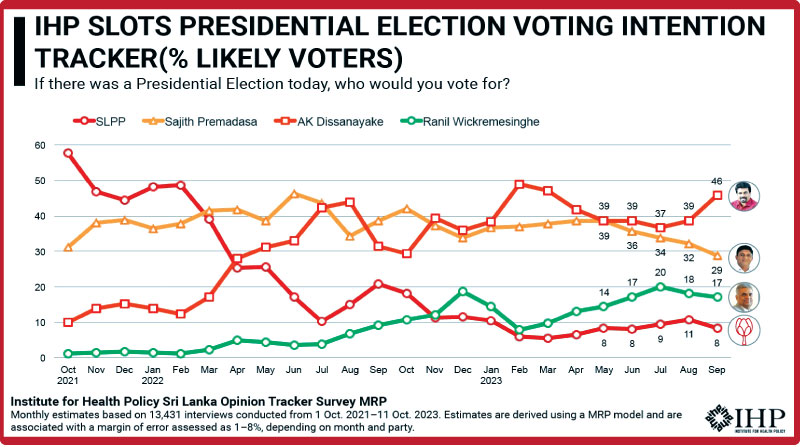
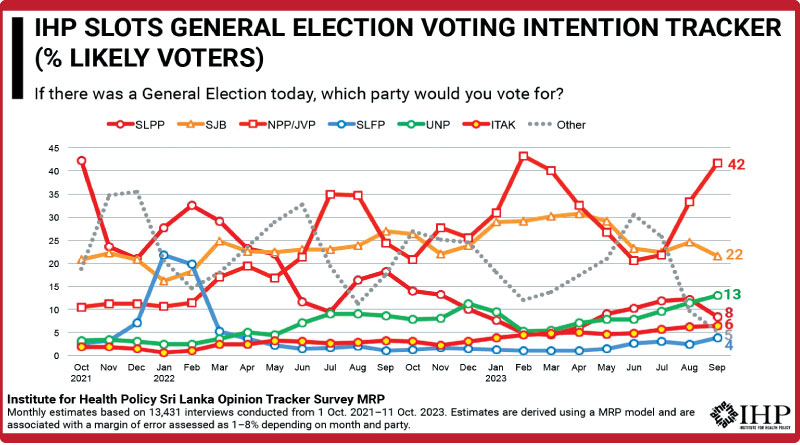
Ranil can’t get elected
Ranil and the UNP are running a poor third in the polls.
 Ranil on 17% is running almost 30% behind left candidate Anura Dissanayake.
Ranil on 17% is running almost 30% behind left candidate Anura Dissanayake.
 Wickremesinghe is polling well under half and a little over a third of the left leader’s popularity score.
Wickremesinghe is polling well under half and a little over a third of the left leader’s popularity score.
 In the parliamentary stakes, the UNP on 13% is running almost 30% (29%) behind the left-populist NPP-JVP.
In the parliamentary stakes, the UNP on 13% is running almost 30% (29%) behind the left-populist NPP-JVP.
Dr. Harsha de Silva’s formula of several months back, that ‘ideological factors’, chiefly ‘a shared economic ideology’, should be the basis of choice at the upcoming election, will fail. The UNP’s 13% added to the SJB’s 22% totals 35%, which falls behind the NPP’s 42% (and climbing).
Sajith’s 29% and Ranil’s 17% do add up to AKD’s 46% but that calculation ignores the probability that Sajith scores appreciably (7%) more than his party precisely because he pulls in a pro-[President] Premadasa populist protest vote which would pivot to the JVP-NPP if SP/SJB were to realign with Ranil and the UNP.
The opinion polls also show that:
 The time factor is not working in favour of the SJB.
The time factor is not working in favour of the SJB.
 It is working in favour of the UNP only infinitesimally and at a snail’s pace.
It is working in favour of the UNP only infinitesimally and at a snail’s pace.
 The UNP can never catch up with the NPP, while the SJB which could, is sliding downwards instead.
The UNP can never catch up with the NPP, while the SJB which could, is sliding downwards instead.
 Time is working in AKD and the NPP’s favour. AKD’s popularity grew at a dramatic 7% last month.
Time is working in AKD and the NPP’s favour. AKD’s popularity grew at a dramatic 7% last month.
 Extrapolated, it is evident that neither the SJB nor UNP on its own nor together can outstrip the AKD-NPP combination.
Extrapolated, it is evident that neither the SJB nor UNP on its own nor together can outstrip the AKD-NPP combination.
Rightward shift, soft on Ranil
Everything Sajith said in the presidential election campaign of 2019 was validated during Gotabaya’s tenure and yet that hasn’t taken him from 42% to 50%. Paradoxically, his popularity seems to have gone in the opposite direction.
AKD and the NPP are growing because they are producing and supplying the ‘electoral marketplace’ with something it needs, while the SJB isn’t. AKD and the NPP’s exponential growth is traceable to 3 factors:
i. Sajith’s failure to seize the chance of the Prime Ministership in April 2022 which would have put him in line for the Presidency. Field Marshal Sarath Fonseka recently identified those who sabotaged Sajith: “…I am against the fact that Sajith did not accept the Prime Ministership...We had to assume the Prime Ministership. Sajith was also willing to do so. But it was stopped by Harsha, Eran and Kabir who were in charge of the party’s economy (sic).” (mawratanews.lk)
ii. The post-Aragalaya abdication of the SJB from the role of the main Opposition, after Ranil’s installation as President. The SJB supported the IMF deal and the Central Bank bill despite Ranil’s sabotage of the local government election.
iii. The ideological/policy influence of Harsha-Eran-Kabir which ensures that the SJB doesn’t come across as anti-Ranil, or comes across precisely as not anti-Ranil. When Sajith, responding to Ranil’s policy speech in Parliament, correctly critiqued the strategy of shrinking the economy, Harsha defended it the next day.
The Buddha’s point about Brahmins holds true in all things. It is deeds that define and determine.
 The main Opposition is the one that actually fights against the anti-people, anti-national policies of the Government, not one that observes a ceasefire vis-a-vis an unelected ruler who steals elections and employee savings.
The main Opposition is the one that actually fights against the anti-people, anti-national policies of the Government, not one that observes a ceasefire vis-a-vis an unelected ruler who steals elections and employee savings.
 An Opposition party cannot share an economic policy with the ruler and still be thought of as ‘the alternative government’. You cannot position yourself as a superior substitute and be regarded the alternative.
An Opposition party cannot share an economic policy with the ruler and still be thought of as ‘the alternative government’. You cannot position yourself as a superior substitute and be regarded the alternative.
 One cannot be the main Opposition simply arithmetically, without being the main anti-incumbent, i.e., anti-ruler Opposition.
One cannot be the main Opposition simply arithmetically, without being the main anti-incumbent, i.e., anti-ruler Opposition.
The ‘centrist’ SJB, isn’t centrist. It is center-right in its economic program and discourse. Joe Biden and Jake Sullivan’s economic ideology (‘Bidenomics’) is centrist. Barack Obama’s policies (‘Obamacare’) were centrist. The US Democrats are centrist. Keir Starmer’s Labour Party is centrist. The populist Peronist party’s Economy Minister Sergio Massa running ahead of the pro-’dollarization’, anti-China, anti-state sector Javier Milei in Argentina’s presidential race, is centrist. The SJB with its Economic Blueprints 1.0 and 2.0, is not.
The SJB still remains almost at the 23% (22%) it scored in August 2020 on its first outing as a new party. The UNP under Ranil was reduced to 23% at the local government election of Feb 2018. The SJB simply took over the 23% that Ranil had reduced the country’s largest single party to. But how is it that having scored 23% in August 2020 running against the SLPP, the SJB hasn’t benefited from the collapse of the SLPP’s popularity, and has stagnated or descended a notch to 22% after three years as the main parliamentary Opposition?
Sajith has shrunk from 42% to 29%, the low 40s to the high 20s, moving towards his party’s standing in the low 20s.
The trajectory tells the story. Instead of Sajith (42% in 2019) being followed by the SJB (23% in 2020), the opposite happened. Sajith on 42% in 2019 is only on 29% in 2023, while his party which was on 23% in 2020 is at 22% in 2023, because the leader has been taking the cue from his party, thereby moving downwards, rather than the party following the leader, thereby moving upwards.
The party has remained shrunken, while its leader’s popularity seems to be shrinking to within range of the 23% that Ranil Wickremesinghe shrank the UNP to.
Ranil’s presidency hasn’t restored his party even to the dismal 23% it had when it lost the local government election of February 2018. Logically then, it isn’t primarily to Ranil’s UNP that the SJB has lost potential votes and political space.
On his 91st birthday, the architect or manager of Sri Lanka’s Open Economy, Ronnie de Mel told Sajith Premadasa (accompanied by Harsha de Silva) that to save the country he would have to “get everything under the control of your [Sajith’s] own policies which I have been observing carefully” and went on to urge a return to the open economy albeit with a strong infusion of “socialist values”. Instead of acting in accordance with the sage counsel of Ronnie de Mel, or adopting a policy matrix which is a Ranasinghe Premadasa-Ronnie de Mel fusion/remix, the SJB chose continuity with the 2015-2019 model of two electoral, intellectual and economic lightweights by comparison: Ranil Wickremesinghe and Mangala Samaraweera.
Far from reviving the Opposition through rebranding and social repositioning as the JR-Premadasa UNP did (1973-1977), the SJB wallowed in the stagnant electoral pond that Ranil- Mangala left the UNP, dreaming of becoming the next/new UNP. It succeeded in retrieving that Golden Fleece, and is now at a grand 22% in the opinion polls.
Instead of reinforcing his own developmentalist economic philosophy with ‘more socialism’ (as Ronnie de Mel recommended) and support from the SJB majority of young populist MPs, Sajith diluted his line to match the consensus within the party’s Royal-Thomian elite. The SJB’s discourse settled at the lowest common denominator, namely its policy heritage of the Wickremesinghe administrations openly referred to as “our government”. Thus “our government” wasn’t Premadasa 1989-1993 but Ranil 2001-4 and 2015-2019. Sajith thereby descended from his 42% (Nov 2019) into the higher 20+% range, instead of climbing the 8% from 42% to 50%.
Sadly, SJB foreign policy too isn’t animated by the spirit of President Premadasa but haunted by the ghost of Mangala Samaraweera. Even as PM, Premadasa was a champion of the Third World and its struggle for economic justice and South-South cooperation, but the SJB never mentions the Global South, BRICS Plus, the BRICS Bank (NDB), G-77 & China, and the new Global South-driven consensus in G20.
It is not above tilting to the Quad and dog-whistling about China. It could deviate from Nonalignment and embrace ‘multi-alignment’ (as preached by Eran Wickremaratne).
Sajith’s story
Without a strong progressive center, a country in socioeconomic crisis is doomed to de-stabilizing political and ideological polarization. The way to forestall it is not to reinforce the Right but to (re)construct a strong social democratic center.
SWRD Bandaranaike successfully interposed himself between the rightist UNP and the Marxist Left, by clearing a Middle Path, attracting the ‘Five Great (Social) Forces’ and uniting his SLFP and Philip Gunawardena’s VLSSP as the MEP. The ‘Silent Revolution of 1956’ was an MEP victory.
Sajith Premadasa is the main voice FOR the people, but not yet recognizably OF the people. To win, he must become like his father Ranasinghe Premadasa, the main voice OF the people and FOR the people. He can’t do that on a technocratic policy platform. It is utterly unthinkable that Ranasinghe Premadasa would have run for president in 1988 on a policy platform drafted by Gamini Dissanayake and Lalith Athulathmudali. In a society caught in a poverty pandemic and foreignization (sell-off) frenzy what would be really ‘Smart’ is a 2024 edition of the Premadasa Project and its platforms, especially Janasaviya.
At the end of the Game of Thrones, Tyrion Lannister (Peter Dinklage) concludes that everything has taught them the power of ‘the story’; of a compellingly persuasive narrative which seizes the collective imagination. The scriptwriter was obviously recycling Prof. Joseph Nye’s ‘soft power’ concept. At a packed event at the IFRI, Paris, Joe Nye admitted in response to me that his ‘soft power/smart power’ concept was inspired by Antonio Gramsci.
Nobody has a better story to tell than Sajith Premadasa. At its heart is the hero, a great leader, the champion of the people, the enemy of poverty, Ranasinghe Premadasa; his Presidency a developmental Camelot. Sajith’s quest and mission, should be to resume and complete President Premadasa’s unfinished revolution. Sajith Premadasa’s story is the sequel to his father’s. He stands or falls with it. So does the System’s balance. Sajith isn’t telling the story.
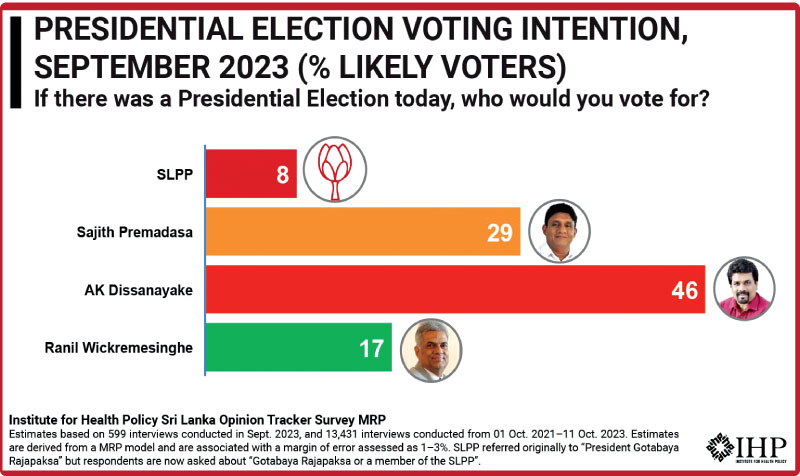
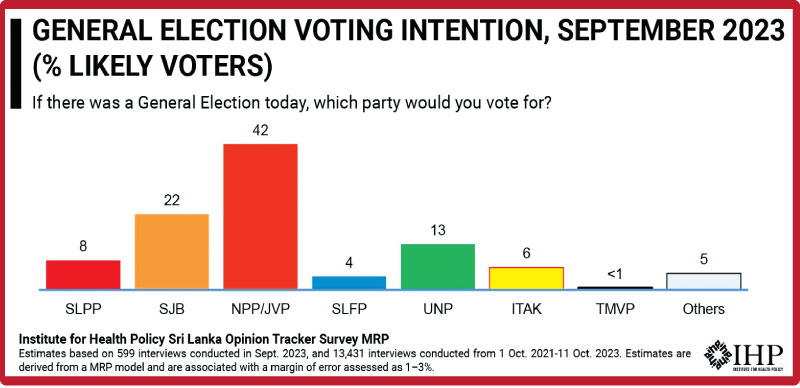
AKD’s Kerala card
The left-populist NPP political movement (probably inspired by Fidel Castro’s July 26th Movement) and its leader Anura Dissanayake have picked up the slack left by the SJB’s rightward shift.
The JVP-NPP has skyrocketed from 3% in 2020 to 42% -- Sajith’s Nov 2019 score. Anura himself is at 46%, having climbed 7% in a month—primarily because he is the main anti-incumbent voice. https://youtu.be/6UIPef5fO0s?si=kVsdCQhbZL2DE98q
Any candidate and party anywhere that are as close as AKD and the NPP to winning an election as indicated by public opinion polling, would adopt an inclusionary approach by narrowing the target to the incumbent and his/her partners (e.g., Ranil, Gota, Rajapaksas) while finding some positive aspect to commend about previous periods, governments and leaders (from DS to MR), thereby securing cross-party support from voters. It would ‘top up’ by constructing a united front/bloc, to vault the 50% mark.
Instead, the JVP-NPP wishes to cut away from all parties which have governed hitherto, and project itself as the sole alternative, which the electorate should by process of elimination, choose as the governing party this time. If Anura and the NPP-JVP are able to shift from a single-party movement, i.e., from party-political monopoly, to the leading and main (but not exclusive) role in a left-progressive bloc, they’d probably win most elections.
To win, that’s not the only problem that AKD and the NPP have to address. Voters will assess whether they have the macroeconomic model, roadmap and skills-set to make things better, rather than engage in risky experiments sourced in obsolescent thinking such as regarding the Open Economy of 1977 as the root cause of the economic crisis. In fairness I must add that in his noteworthy Q/A in LA, Anura suggested 4 methods, including the AMUL model of ‘reorganizing’ enterprises, of pragmatic economic regulation.
(https://www.youtube.com/watch?v=pDYcoSecemo&t=1s)
AKD and the NPP-JVP should:
i. Win over and induct progressive economic heavy-hitters such as Prof Howard Nicholas and Dr. Nishan de Mel who can strategize complex policy while also handling international economic negotiations.
ii. Play the Kerala card. Kerala’s democratically-elected leftwing coalition government has performed admirably in the economic realm, combining sustainable growth and high human development. The Kerala government should be requested to provide an advisory team or at least one leading economic expert from among those responsible for Kerala’s economic success.
The JVP should publicly commit itself to the Kerala model or an adaptation, and perhaps name the expert/s who will advise an AKD presidency and/or NPP-JVP administration. Anura Dissanayake should visit Kerala and meet the Chief Minister and her Cabinet. He could also visit Nepal for discussions with successful left leader and Prime Minister Pushpa Kamal Dahal.